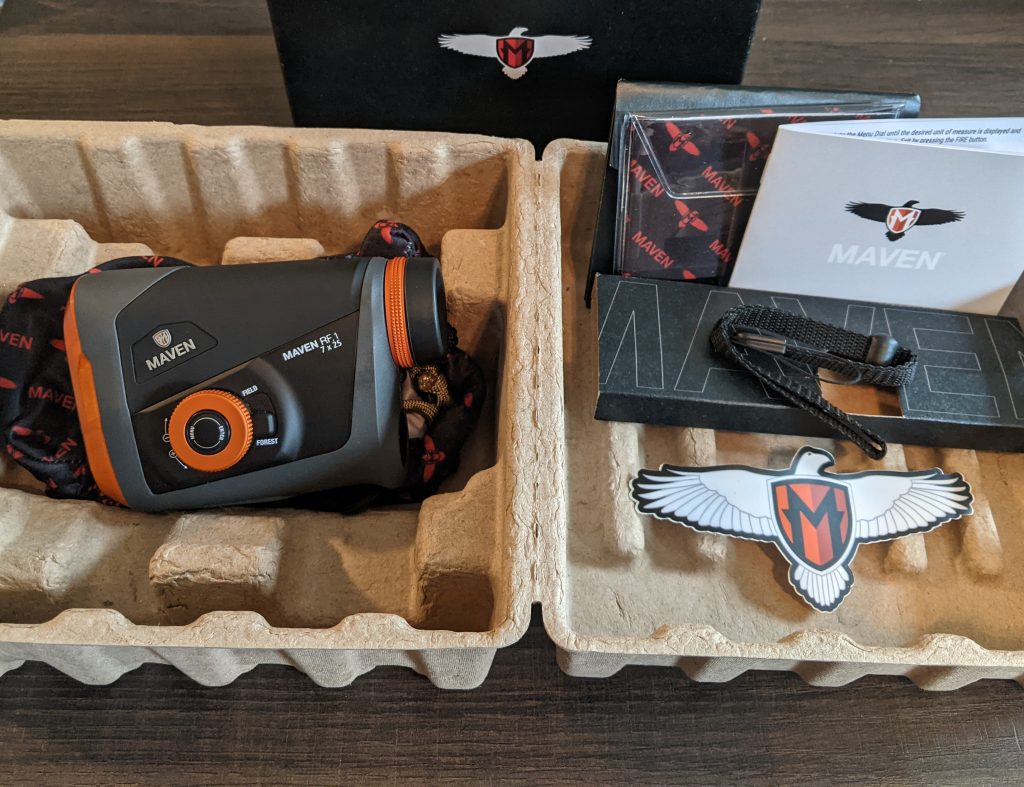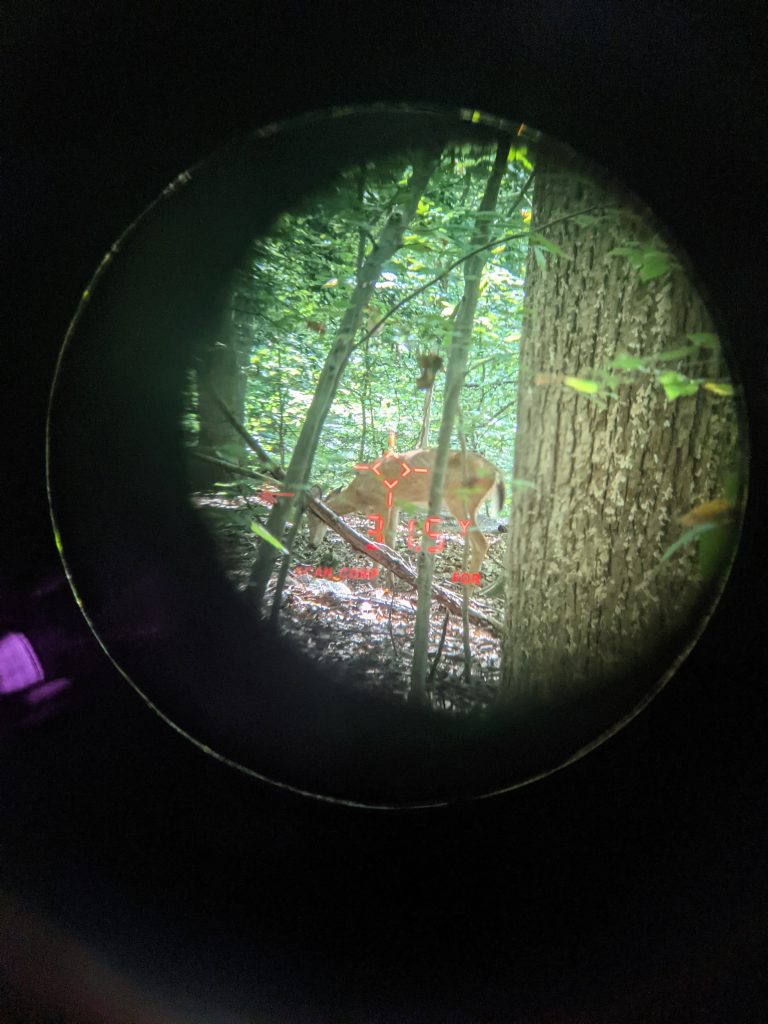![Maven_RF1_bow[14134]](https://gatdaily.com/wp-content/uploads/2022/03/Maven_RF1_bow14134-696x522.jpg)
About the Company
Last August we posted all about Maven as a company. They are a company that cuts out the middle man to keep prices down yet still delivers the same great glass as other competitive scope and binocular companies. Coming from a long line of hunters, Maven makes Scopes, Binos, and Rangefinders made for the outdoorsman. Below is a review from an outdoorsman about their RF.1. A 7×25 rangefinder with the ability to range from 5-4500 yards and with a great price tag of $450. Mind you, the Maven RF.1 was awarded Outdoor Lifes Great Buy Award of the year because it’s “a powerhouse of both utility and innovation. It was one of the most powerful and sensitive units we tested, the controls are smart and useful, and the price is extremely competitive.”-Outdoor Life
Review of the Maven RF.1 7×25 Laser Rangefinder
Disclosure: I received this unit on loan from a manufacturer representative for evaluation.
Overview: The Maven RF.1 is a compact, hand-held laser rangefinder for use by shooters to range targets from 5 to 4500 yards. It is designed to be easy to use and ultra portable.
First Impressions: The packaging is simple, a cardboard sleeve over a cardboard clamshell container that resembles a takeout box from your local fast-casual restaurant. I appreciate a company that doesn’t waste money on elaborate packaging, which cuts into a product’s value. Enclosed within the box were the RF.1 rangefinder, a small instruction manual, a wrist strap, a lens cloth and a sticker.
I read the instruction manual and removed the battery cut off sticker. The unit powered up, and I immediately stepped onto my back patio to start ranging things around the neighborhood. The controls and menus are so easy to use, I never had to go back to the manual again. Switching from yards to meters, adjusting brightness, selecting line of sight vs. angle compensated ranging, cycling through reticles – all were super intuitive and easy.

Features: The manual describes everything so clearly and concisely that I won’t try to rehash what Maven printed. But essentially the features built into the unit allow you to look at something and know precisely (within half a yard) how far away it is within a few seconds. There’s a threaded tripod/camera style mounting interface on the bottom of the unit, but I think a device such as the RF.1 is best suited for hand-held field use.
Use in the Field: I am currently training with a compound bow to take up deer and possibly turkey hunting. I have never hunted, and am working with friends, coworkers or anyone I can find to get a chance to get opportunities to learn the ropes. Until I get a guide/hunting partner to take me out, I’ve been practicing to get as proficient as possible with my bow so I know I can make a clean shot on any game I get a chance to harvest.
The included wrist strap didn’t seem like something I’d like to use with the bow, so I added a large loop of paracord to the RF.1 so I can carry it slung across my body, easy to access at a moment’s notice. As I live in suburbia outside of Washington, D.C. I needed a place to hone my archery skills, so I joined a club. The club I joined has a 28-target field course and a very impressive 30-target 3D target course. This would be the perfect place to try the RF.1 and familiarize myself with its operation before embarking on a hunt.
As part of my “trust, but verify” modus operandi, I wanted to see if the RF.1 was indeed as accurate as the manufacturer stated. I headed to the target range, where the club has 20, 25, 30 and 35 yd targets for members to practice and zero the sights on their bows. The RF.1 ranged all but one target exactly on, with the 4th (35) within 0.5 yards. I didn’t bring a distance measuring wheel to check the exact distance over rough terrain, but we’ll call that dead on for practical purposes.
Ranging targets on the field course proved to be a similar experience. I used the “forest” environmental condition setting since the course is located entirely within your standard mid-Atlantic forest. Most targets are on a flat plane or barely downhill, so the angle compensation didn’t give me significantly different readings. After verifying that the RF.1 could accurately pinpoint distances, I moved to the 3D course.
The 3D course has absolutely zero distance indicators for any target. The targets range from deer and elk to bears, tigers, giant novelty spiders and dinosaurs. The lanes of fire are often narrow and uphill or downhill in difficult terrain. The size of the “animals” isn’t always to scale, and I’m inexperienced so my guesses for range were often wrong by 10-15 yards, making the RF.1 absolutely essential for dialing my single-pin sight for the correct distance. I obviously need some work on my archery abilities, but confidently knowing the exact distance to target, or reference points from a blind is great. I hope to have this rangefinder on me when I finally do get that opportunity to hunt!
On my last visit to the club, I was walking the trail out to the second half of the field course to practice when I noticed movement and heard rustling about 15 yards to my 2 o’clock. It was a doe I had spooked! She ran a short while before stopping behind a tree. I had time to gently set my bow down and grab the RF.1 from my pants pocket, and was able to range her, standing perfectly broadside. I then got my phone out and snapped a pic through the RF.1 (attached here). Being able to quickly use this rangefinder to check distance on a live target was amazing. It was a huge confidence boost, knowing that I should be able to do this on a hunt.

As a final note, I will say that I did not test the RF.1 in harsh conditions aside from some very hot (90F+) and humid (80-90%) days. I did not submerge it in water, chuck it against rocks or anything else. As a piece of precision equipment, I don’t want to risk damaging something designed for helping me place accurate shots on target. I did use sunscreen and strong bug repellent (25% DEET), which did not degrade the finish or controls any more than showing some slight wear to the soft touch plastic finish on defined edges.
Final Impressions: The RF.1 is an excellent field tool for hunters or wildlife enthusiasts. I’m sure it would be great for long distance rifle shooting as well, but I did not have opportunities to test the unit in that role. I was very impressed with how easy the RF.1 is to use, and would trust it on a hunt without reservation. It’s lightweight and compact, and the bright copper/orange colored accents make it easy to find if dropped in the woods or grass.



